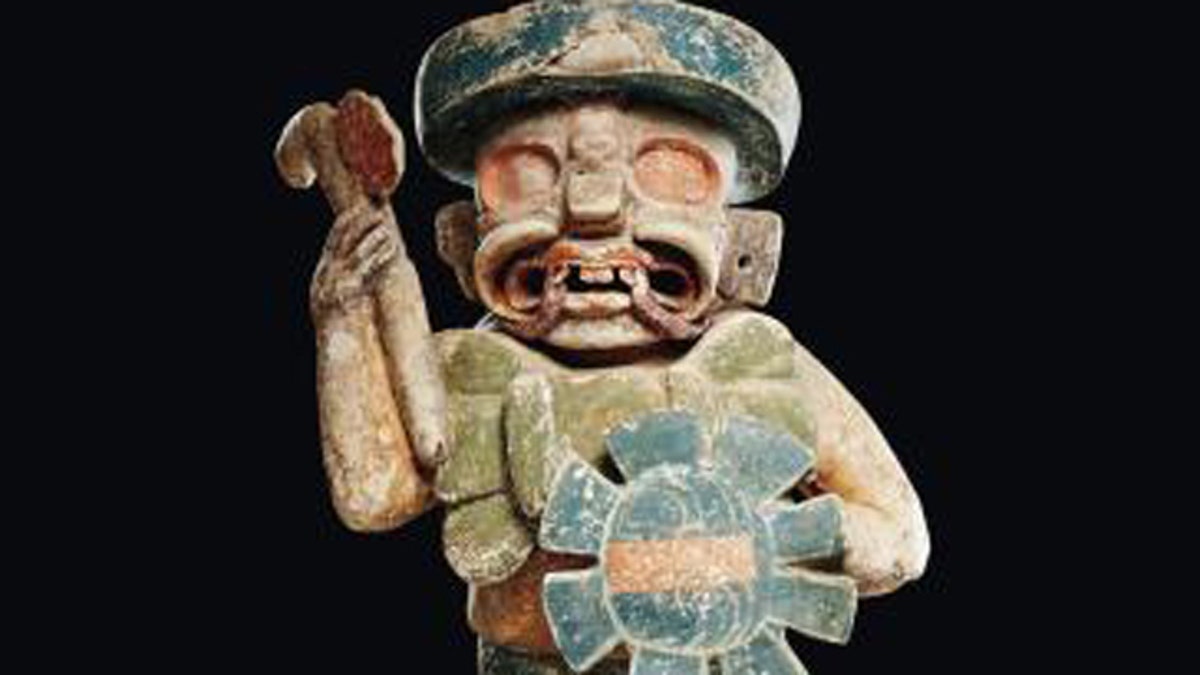
The Mexican government on Wednesday said a Mayan-style statue that brought a record $4 million (2.9 million euros) at auction this week is a fake. Auctioneers vow it is genuine and claim Mexico wants to quash legal sales of pre-Hispanic artifacts. (AP Photo/Binoche Et Giquello)
MEXICO CITY – The Mexican government argued Wednesday that a Mayan-style statue auctioned for a record $4 million (2.9 million euros) this week is a fake. Auctioneers insisted it is genuine and charged Mexico wants to quash legal sales of pre-Hispanic artifacts.
The stakes in the dispute are high -- and not just because of the cash laid down by the as-yet unidentified buyer. A debate has been renewed about whether there is a place, if any, for sales of ancient artifacts.
The Paris-based Binoche Et Giquello auction house that sold the stucco figure of a shield-toting stucco warrior said the attack on its authenticity is an attempt by Mexican officials to shake confidence in the auction market for pre-Hispanic artifacts.
"They want to ruin the market for pre-Hispanic art, that is my opinion," said auctioneer Alexandre Giquello.
Damaging the legal market could push such pieces onto the unregulated black market, he said. Auction houses are subject to public scrutiny, provenance and ownership challenges, while "on the black market, you have no control at all," Giquello said.
He said the statue -- 5 feet (1.56 meters) tall and colored in blue, green and orange -- has been publicly written about since 1976. The piece has been examined by experts, exhibited and discussed in professional forums and publications, he said.
Titled "seated divinity," the figure was dated by the auction house to between A.D. 550 and 950.
Mexico's ministry in charge of archaeology disputed that.
"It is a recently manufactured piece that does not belong to any of Mexico's pre-Hispanic cultures," the National Institute of Anthropology and History said in a statement.
The institute's experts described the fierce-looking warrior as a sort of "freestyle" mishmash of elements that never existed in one single culture, like lace-up sandals of a kind the Mayas didn't use. The experts also said the knees-bent position of the statue didn't match Maya styles, though Giquello said the figure had been seated on a throne that was now missing.
The Mexican agency acknowledged it judged the statue's authenticity based solely on photos, a practice that experts say is questionable.
So there is a buyer either holding a very important Mayan artifact -- or a very expensive piece of junk.
Either way, Dr. Richard Leventhal, a University of Pennsylvania anthropology professor and the director of the Penn Cultural Heritage Center, said he doesn't have much sympathy for the mystery buyer.
Leventhal said such purchases, even if carried out on the public auction market, legitimize the black market by teaching tomb robbers and middlemen they can make a buck with artifacts. When dug up by looters instead of archaeologists, such artifacts become divorced from the valuable information that comes with their context.
"I am assuming that anybody who spent that much money has been doing due diligence," Leventhal said. "But even if it were fake, no, I wouldn't have too much sympathy for that person."
A 1972 Mexican law limits private collections of antiquities. Collectors were permitted to keep pieces already in their possession at that time, if they registered them with the government. Anything excavated since then is considered the national property of Mexico. Exports of pre-Hispanic artifacts are banned.
